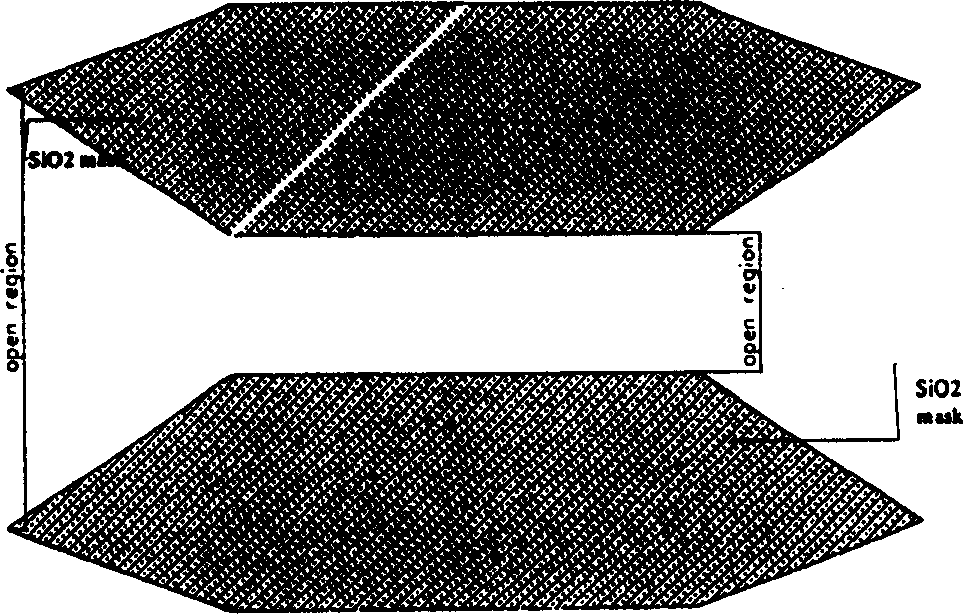Integration of continuous self-aligning semiconductor photoelectronic device and mode spot converter
A technology for optoelectronic devices and mode-spot converters, which is used in semiconductor lasers, semiconductor/solid-state device manufacturing, laser parts and other directions, and can solve problems such as large strain differences, difficulty in obtaining high-quality materials, and high crystal quality.
- Summary
- Abstract
- Description
- Claims
- Application Information
AI Technical Summary
Problems solved by technology
Method used
Image
Examples
Embodiment 1
[0032] Example 1: Integration of polarization insensitive semiconductor optical amplifier SOA+SSC
[0033] The polarization insensitive semiconductor optical amplifier prepared by the present invention is integrated with the SSC, and the preparation steps include the following:
[0034] 1) Use metal organic chemical vapor deposition (MOCVD) to sequentially grow InP buffer layer, InGaAsP (InGaAsP) lower waveguide layer, InP isolation layer, SOA active area, and InP on an n-type indium phosphorus (InP) substrate. Protective layer (e.g. figure 1 Shown);
[0035] 2) Use ordinary photolithography etching technology to photoetch the SSC area to the InP isolation layer, such as figure 2 Shown
[0036] 3) Using plasma chemical deposition technology to grow SiO 2 150nm;
[0037] 4) Use as image 3 Lithography etched out Figure 4 Graphics
[0038] 5) Use hydrochloric acid to etch away the InP protection layer in the SOA part and the indium phosphorus isolation layer in the SSC area;
[0...
Embodiment 2
[0048] Embodiment 2: Integration of electro-absorption modulator and SSC
[0049] This kind of device is exactly the same as Special Case 1 in the electro-absorption modulator and SSC integration part, but in the subsequent process, according to the characteristics of the electro-absorption modulator, a ridge waveguide structure needs to be used and the production of electrodes needs to be filled with a low-dielectric constant dielectric substance. And the use of pattern electrodes.
Embodiment 3
[0050] Embodiment 3: Integration of Distributed Feedback Laser (DFB) and SSC:
[0051] This kind of device is almost the same in the integration part of DFB and SSC as Special Case 1, but because DFB is a light-emitting device, it only needs to be integrated with SSC at a single end. After completing the selective growth SSC part, the following preparation steps must be adopted:
[0052]1) The protective layer InGaAsP and the cap layer InP are sequentially etched away with a selective etching solution;
[0053] 2) Make a grating in the DFB part, as shown in Figure 6(a);
[0054] 3) P-InP cap layer and InGaAsP protective layer are grown on the grating and SSC, as shown in Figure 6(b);
[0055] 4) After that, the BH strip waveguide structure is prepared in the same way as in Special Example 1.
[0056] 5) According to the high frequency characteristics, pattern electrodes should be made on the DFB side;
[0057] 6) Plating high reflection film on one end of DFB and antireflection fi...
PUM
 Login to View More
Login to View More Abstract
Description
Claims
Application Information
 Login to View More
Login to View More - R&D
- Intellectual Property
- Life Sciences
- Materials
- Tech Scout
- Unparalleled Data Quality
- Higher Quality Content
- 60% Fewer Hallucinations
Browse by: Latest US Patents, China's latest patents, Technical Efficacy Thesaurus, Application Domain, Technology Topic, Popular Technical Reports.
© 2025 PatSnap. All rights reserved.Legal|Privacy policy|Modern Slavery Act Transparency Statement|Sitemap|About US| Contact US: help@patsnap.com



